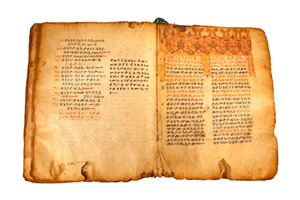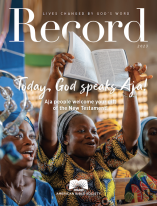A Living History of God's Word

The Verbum Domini exhibit, sponsored by American Bible Society and the Green Family, now showing at Vatican City and running until April 15, assembles more than 150 of the world’s rarest bible text and artifacts from the Green family collection.
“As we consider the Bible artifacts in this collection, we are reminded that we stand on the millennia of faithful men and women,” said R. Lamar Vest, president of American Bible Society, which cosponsored the exhibit. “By continuing the work of Bible engagement in the 21st century, we are writing the next chapter in biblical history.”
Items on display, which are significant to people of various faith traditions, include:
- The Jeselsohn Stone or Gabriel's Revelation, a 3-foot-tall sandstone tablet — discovered near the Dead Sea in Jordan, weighing 150 pounds and containing 87 lines of Hebrew — written in the first century BCE
- The Blood and Body of Christ Being Real and Present in the Sacrament, a manuscript from 1534 ascribed to Thomas More, written in Latin and containing numerous references to Scripture, about the Roman Catholic teaching of transubstantiation
- Richard Rolle’s Psalms, Canticles and Commentary, the earliest, most extensive surviving manuscript of the translation and commentary of Psalms and the Canticles in Middle English, composed 40 years before Wycliffe’s vernacular translation of Scripture
- Hagia Sophia Lectionary, a mid-11th century manuscript that contains Scripture readings, along with a list of ceremonies of the great Church of Hagia Sophia, the seat of the Eastern Orthodox Church and the place where the emperor worshiped.
“As the world travels to Rome for Lent and Easter, where hundreds of thousands of people will visit St. Peter’s Square, there is no better stage on which to share the history of God’s Word with people of all faith traditions,” said Steve Green, who oversees the development of the Green Collection.
“The exhibit is not just a celebration of the past, it’s a living book that speaks to every generation and culture,” says Geof Morin, Chief Communications Officer of American Bible Society. “So many men and and women risked so much and worked so hard to faithfully pass on God’s Word throughout history and around the world. Now it’s our responsibility to put God’s Word into practice in our own lives.”
Thanks to the support of our faithful financial partners, American Bible Society has been engaging people with the life-changing message of God’s Word for more than 200 years.
Help us share God's Word where needed most.
Sign up to stay in touch with how God is changing lives with his Word!








